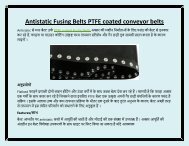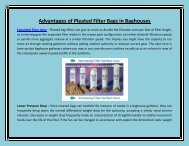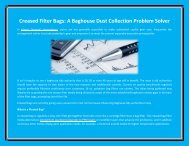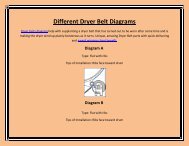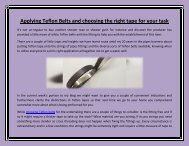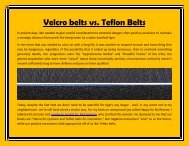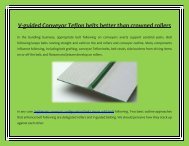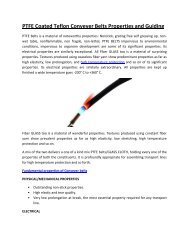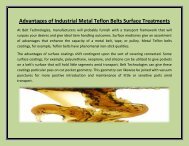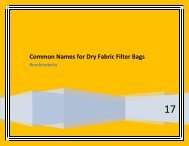High Heat Filtration with Industrial Air Filter Bags
The general flow is aimed from outwards to inside the filter. It also is dependent on the size of application. The segregation of the particles occurs externally surface of the filter. This is different from other filters where the separation occurs inside the filter bags - http://www.bombinobelts.com/product/filter-bags
The general flow is aimed from outwards to inside the filter. It also is dependent on the size of application. The segregation of the particles occurs externally surface of the filter. This is different from other filters where the separation occurs inside the filter bags - http://www.bombinobelts.com/product/filter-bags
You also want an ePaper? Increase the reach of your titles
YUMPU automatically turns print PDFs into web optimized ePapers that Google loves.
<strong>High</strong> <strong>Heat</strong> <strong>Filtration</strong> <strong>with</strong> <strong>Industrial</strong> <strong>Air</strong> <strong>Filter</strong> <strong>Bags</strong><br />
Solution filter bags can be classified as sediment filter systems. Sediment essentially pertains to the<br />
particulate matter that flows <strong>with</strong> the chemical under consideration. When this water is built to stand<br />
still the sediment will be placed as a solid coating at the bottom of the container. Similarly, when the<br />
liquid is strained, the sediments will be obstructed by the carrier filter material whereas the liquid<br />
will flow away, emerging much clearer.<br />
Inside a professional application, there are a lot particulate contaminants that flow <strong>with</strong> process<br />
fluids. These could include items of rust that are carried by the chemical as it flows through pipelines,<br />
organic and natural matter such as fiber, seeds, pulp, particles of soil or clay, etc. All of these<br />
materials usually do not dissolve <strong>with</strong> fluids, and can hence be filtered out using chemical bag filters.<br />
Bag <strong>Filtration</strong>
They are normally used to filter dust in professional filter applications. The general flow is aimed<br />
from outwards to inside the filter. It also is dependent on the size of application. The segregation of<br />
the particles occurs externally surface of the filter. This is different from other filters where the<br />
separation occurs inside the filter bags.<br />
Very useful Particulate <strong>Air</strong> <strong>Filter</strong>s<br />
Incredibly efficient Particulate <strong>Air</strong> <strong>Filtration</strong>, or popularly called as only the HEPA filter systems, are<br />
largely considered as the best amidst all filters. If you make use of it along <strong>with</strong> activated carbon<br />
dioxide or zeolite canister, it is a complete filter by proving its effectiveness against particulates and<br />
odors and lots of gases. The history behind HEPA filter systems goes that it was invented by the<br />
Atomic Energy Commission to provide a safe environment for their researchers operate and keep them<br />
safe against radioactive dust particles. The Great Efficiency Particulate <strong>Air</strong> filtration is incredibly<br />
effective against air particulates that are as small as 0.3 microns and <strong>with</strong> an outstanding efficiency<br />
rate of 99. 97%. This means, from ten thousand articulates present in air, only 3 particles would not<br />
be caught by the purifier. The DUST filters are mostly used for laminar airflow cabinetry.
Bag filters remain one of the most cost effective techniques for filtering dust particles and particulate<br />
matter from gas streams caused when professional processes vent their exhaust. The technology, like<br />
all good technologies, is simple and effective, still relying on fabric hand bags to do almost all of the<br />
filtering work. Because the major changeable component of a filter (the bag) is relatively<br />
inexpensive, the complete filtration system can be very economical to operate: an excellent solution<br />
to hot gas filtering in the age group of recession.<br />
<strong>Filter</strong>s for bags come in a variety of different types and forms - the only common factor in all of them<br />
being the bag. The way the gas is aimed through the filters, and the way the complete filtering unit is<br />
run to ensure continual cleaning even when regions of the filter's interior are soiled, changes from<br />
application to application. Indeed, a handbag filter can even contain bag material <strong>with</strong>out actually<br />
containing bags: so the gas is filtered through those woven stuff that a bag would be made of, though<br />
not actually collected in a sack.
Simple filter bags systems allow gas to give food to them by way of a series of suspending bags. The<br />
bags choke brake dust particles away of the gas quite naturally - the gaseous particles can pass<br />
through the gaps between the fabric fibers, nevertheless the dust particles cannot. The efficiency of a<br />
filter actually increases (up to a point) as more dust particles gets trapped - the caked dust rubs<br />
carefully up against the fabric of the bags, which creates an electrostatic charge. That demand<br />
attracts more dust to the filter and so speeds up the filtering process.




